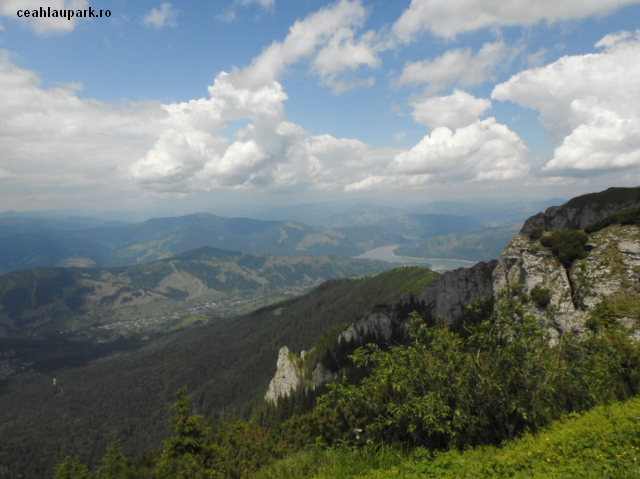Ceahlau National Park
The Ceahlau National Park is a protected area of national interest, situated in northeastern Romania

Daniel Onea, 03.02.2022, 02:02
The Ceahlau National Park is a protected area of national interest, situated in northeastern Romania, in the Ceahlau Massif, spreading over 7,000 ha. In these mountains, tourists can find deep forests, alpine pastures, isolated crags, and nature monuments. You can also see a sedimentary rock mountain massif. It is a very particular formation, with rock structures shaped by water, wind, freezing and thawing, and other natural phenomena. Liviu Moscaliuc, head of office and biologist with the Ceahlau National Park Administration, told us about it:
“There are many crags and rocks here, and they have their own legends. In addition, the park preserves a sample of mountain ecosystem typical of the Carpathian Mountains, which means that here we find forests, high pastures, and many animal species, some of them large carnivores: wolves, bobcats, bears, and wildcats. One of the main aims of the park is to promote quality tourism. In this context, we have eight marked trails, most of them going from the foot of Ceahlau mountain to its peak. There are also two connecting trails. All are properly marked, and available for any level of training. However, we advise tourists to visit us, and also take precautions typical of mountain treks: several layers of clothing, boots or sneakers suited for this, possibly with crampons, sweet foods, water, flashlight, depending on the season.”
The mountain is visited mainly by Romanian tourists, and the number of visitors is growing by the year, according to Liviu Moscaliuc with the Ceahlau National Park administration:
“Last year we had 70,000 paying visitors. There is a fee for trails, which is then used for park administration. By comparison, two years ago we had 50,000 visitors. We have visitor trails, and an information center in Durau, close to the mountain. There is also a visitor center in Izvorul Muntelui. It has three main rooms, with models of the crags, telling their stories. There you can find out about the legends around Ceahlau. There is a 3D cinema, and some play rooms for kids. The audio and written materials are available in English.”
Of the total number of tourists going to Ceahlau National Park last year, two or three thousand were foreign, says Liviu Moscaliuc.
“Generally, foreign tourists are very receptive to the advice and information they receive at our information centers. They take it very seriously, as opposed to Romanian tourists, who tend to be more independent. There were many who set up camp at the foot of the mountain, and enjoyed a few days on the trails. At the same time, some were here just in passing, going to the Ceahlau Massif, or to visit other mountains. They generally leave with a good impression. They appreciate the scenery, and the state of the trails, which are cared for by the parks administration and by Mountain Rescue.”
The mountain resort of Durau, which is within the parks boundaries, is recommended for leisure, but also for treating fatigue, anemia, and for recovery after physical or mental effort. The main natural factor for healing is the clean air, free of dust or allergenic particles, and the high ozone atmosphere. Durau can be the starting point for a number of trips, according to Liviu Moscaliuc, our host:
“From Durau we have a very popular trail that leads to Duruitoarea Waterfall. It is a typical waterfall for this area. Also from Durau you can reach the Fantanele Cabin, on to the Toaca Peak, the most popular and imposing peak of the massif. Along the way you have different places to stop for a rest, either viewing points, or representative crags. Up there at the Toaca Peak there is a stairway that leads to the weather station right at the top. This is a major attraction. The stairway has 519 very steep, but safe, steps. There is also the museum in Ceahlau, not too big, but fairly interesting, which displays local animals and artifacts. However, in order to explore the local artisan objects, we advise to visit the town of Targu Neamt, about 40 km away, or the city of Piatra Neamt. In that city we highly recommend a visit to the History Museum, because it showcases exhibits typical of the Cucuteni culture, also known as Tripolye culture.”
In the village of Grinties you can attend the Festival of Haidouks, or outlaws. It is usually held in August, and is a very interesting event, where you can witness the local peasant garb and local traditions, which includes competitions in traditional crafts. As for the local community, the Ceahlau National Park administration plans to promote eco-tourism, centered on the park. Here is Liviu Moscaliuc:
“Inside the park, we want to promote some forms of niche tourism, for people who want to isolate in the wild and get lost in nature for a few days. Also, we want to set up guided tours in the scientific reserves. There you can visit in groups of up to ten, with a guide at all times. We have some impressive scientific reserves, very interesting. For instance, we have a beautiful forest of a certain species, which can be admired from the peak, which is of great interest in October, when that species of trees changes the color of its needles and starts shedding them. It first becomes an intense orange. I remind all that the Ceahlau Mountain, being a national park, has some regulations. One of them is that visiting can be done mostly only on foot. Many people arrive here and ask how high up they can drive. Well, cars can go only up to the resorts of Durau and Izvorul Muntelui. Then they have to go pedestrian. We hope to have lots of visitors, because they have the nature and tranquility here to enjoy.”






























